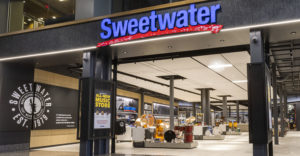
Ninety-one percent of American consumers will walk out of a store and shop elsewhere if they cannot find the particular gift they want, according to a recent Sun Microsystems survey on consumer shopping patterns.
Adults who shop online are equally unforgiving of online retailers that do not have the product they want when they want it: Only 4 percent would buy a different gift on that same site. Technical glitches on Web sites are also likely to result in lost revenue for retailers, with only 35 percent of consumers indicating that they would come back and try later.
The survey’s findings confirm that retailers unable to meet consumer demand and deliver what they want, when they want it, might lose money to competitors. Mike Green, vice president of retail industry for Sun Microsystems, believes that retailers who have made smarter technology investments in four key areas — lead-time optimization, supply chain management, mark down optimization and labor force management — will likely have an advantage over their competitors.
The E-Commerce Times caught up with Green to discuss the biggest challenges facing online retailers today and how to overcome them. Green also offers a sneak peak of his view of the retail store of the future.
ECT: What are the biggest challenges facing online retailers today?
Green: First of all the pure play online retailers are more and more being challenged by the brick-and-mortar companies getting into e-tailing. Some brick-and-mortar chains have done this very successfully. Neiman Marcus, for example, has a very successful combination of brick and mortar and e-tail operations.
Another challenge is security. Security is paramount and it seems no matter how much companies spend on security, there are still people who can figure out how to get around it. The last thing in the world any e-tailer or any consumer wants is to have a security problem. Sun Microsystems has a military grade security system that has never been hacked. Without something like that, it’s going to be extremely difficult to keep consumer confidence up and make sure that they continue to buy online.
ECT: Other than security, what are the key areas that online retailers should be focusing on from a technology perspective?
Green: We still have a long way to go in terms of simplifying the buying process. Online retailers need to focus on simplifying the buying process while at the same time providing what I call “a very entertaining environment.” An entertaining environment could be a very serious environment, but it may be entertaining from the standpoint that it keeps the consumer stuck to that particular e-tailer. A great example is a company called Moosejaw.com. It has a very entertaining environment. People log on just to see what folks are talking about, even if they are not interested in buying something. More times than not, the consumer ends up buying something.
ECT: Your survey mentions lead-time optimization — making sure the right product is in the right store at the right time to eliminate stock-outs — is critical. Can you elaborate on this?
Green: Particularly with online shopping, lead-time optimization is crucial for retailers because consumers visit Web sites in order to purchase a product immediately. Lead-time optimization means that a retailer has the right product at the right time. For online retailers, this requires a higher level of service and constant availability from the inventory standpoint. If a retailer looses a customer online because of technical difficulties or lack of stock, it occurs much more quickly than in a brick-and-mortar setting.
ECT: What are the biggest mistakes online retailers are making in the area of lead-time optimization?
Green: I see problems in the area of lead-time optimization but not necessarily mistakes, except for not implementing a solution that does a good job of lead-time optimization. Lead-time optimization is particularly critical to e-tailers because typically they don’t have the ability to get mark downs in front of consumers as efficiently as a brick-and-mortar retailer does. If a consumer is walking into Sears, they can see sale signs on the racks. It’s much more difficult to find sale items in an online environment. So lead-time optimization and mark down optimization work hand in hand, with lead-time optimization being the most important for an e-tailer. These are classic statements from a retailing perspective that are still true.
ECT: You just mentioned mark down optimization, a focus on the need to eliminate costly overstocked product as quickly as possible by sending it to an outlet store or putting it on sale. Your survey identifies this as an area that online retailers should pay close attention to. Can you elaborate on this?
Green: Whereas least-time optimization addresses the front end of the process, mark down optimization focuses on maximizing inventory dollars once a retailer has the inventory in stock. If a store has the wrong product on the shelves, the retailer needs to free up those inventory dollars for items that are selling well — especially during the holiday season when customers are going into stores to purchase gifts and then returning after Christmas for post-holiday sales, retailers need to get rid of unwanted inventory as quickly as possible.
ECT: What are the biggest mistakes online retailers are making in the area of mark down optimization?
Green: Mark down optimization is not as visible. If you think about an e-tailing site, it’s not as simple to get somebody to look at a markdown area as it is in a brick-and-mortar environment. When you walk into the brick-and-mortar environment, there is signage and displays. When you are in an e-tailing environment, unless somebody specifically goes in searching for all the markdown items, it’s much more difficult to get them that information. And if you are an e-tailer, you are not necessarily going to say to the person coming in, “Hey, I’ve got some great sales,” because that could hurt your full margin sales. You know the customer has a limited pocketbook when they come in. Lead-time optimization is critical to e-tailers. In a perfect world, if you do a perfect job at lead-time optimization, then you would not have any markdowns. That’s the objective.
ECT: Supply chain management should also be a key area of focus for online retailers, according to your recent report. What are the biggest mistakes online retailers are making in the area of supply chain management?
Green: The opportunity I see in supply chain management is to improve the time between when the item is put on a container to the time it gets out of the port. This is especially true in the Far East. Once it gets to the port it can be lost for two weeks. That part of the supply chain could still use some big improvements. With e-tailers, knowing that they have inventory availability is a key part of their value proposition. The more visibility you can bring to the supply chain the better.
ECT: How can e-tailers improve that aspect of supply chain management?
Green: Any supply chain management solution can offer improvements. The problem is that people have not implemented it from a process standpoint. In other words, they typically start the management of the inventory from the time that they take title to it after it gets off the port. Technologies like RFID will help in the future. That technology is not ready for prime time yet. But we still have a lot better inventory visibility today than we did 10 years ago.
ECT: Finally, your survey points out labor force management as a key area on which online retailers should focus. What are the biggest mistakes online retailers are making in the area of labor force management?
Green: Nearly all companies in retail have an influx of shoppers during the heavy buying seasons. Of course, those shoppers go away when the consumer buying season is over. I don’t think there’s any difference between e-tailers and brick-and-mortar retailers in this regard. However, it is very expensive to on-board and off-board an employee in either environment during and after busy shopping seasons. On-boarding is everything from getting the application filed to setting up benefits to setting up work schedules — all of the things that have to happen to get an employee productive in your company. Similarly, when that employee leaves, you have to reconcile any hours that have not been paid, issue a final paycheck, terminate their benefits and all those sorts of things.
ECT: How can online retailers reduce on-boarding andoff-boarding time with technology?
Green: There are solutions — we happen to have one — that make that on-boarding and off-boarding much simpler. In a typical environment, it can take up to two weeks to on-board an employee. In a highly automated environment we can set up using technology, it can take as little as two hours.
ECT: What other technology-related issues stand out to you in regard to online shopping?
Green: Everybody is working toward the ability from a mobile standpoint for consumers to access information. When somebody asks me what is my definition of retail, I say, “It’s anything that has a counter.” Then I hold up my cell phone and say, “This is a counter.” By “counter” I mean the place that the cash register sits. Although there are some companies making strides with e-tailing on hand-held mobile devices, the technology is ahead of the ability of companies to use it right now. That’s not uncommon. Of course, security is extremely important around mobility. Obviously there’s a much different way of hacking in a mobile environment than there is in a typical e-commerce environment.
ECT: What do you think the retail store of the future looks like?
Green: The retail store of the future will reflect retailers’ investment in improving the shopping experience. There will be a combination of traditional brick-and-mortar features as well as e-tailing. Just imagine walking into a brick and mortar store, finding an item that you would like to purchase, but then discovering that the item is not available in your size or color. The next step, in the store of the future, would be that you walk over to a kiosk to scan the tag on the item. The kiosk allows you to order it immediately, thus there is an online completion to the brick-and-mortar cycle. This process will also work the other way around, so if you are shopping online, you could link to a brick-and-mortar environment in order to find the item in your ZIP code. The final step would be to pick up your purchase in the brick and mortar store. The linkage between brick and mortar shopping and e-commerce will be tighter. The online retailer of the future will also create a more enjoyable shopping experience for shoppers. For example, my current favorite shopping site includes funny anecdotes in addition to selling products. My entire family often looks at this site, without even buying anything.























































Social Media
See all Social Media